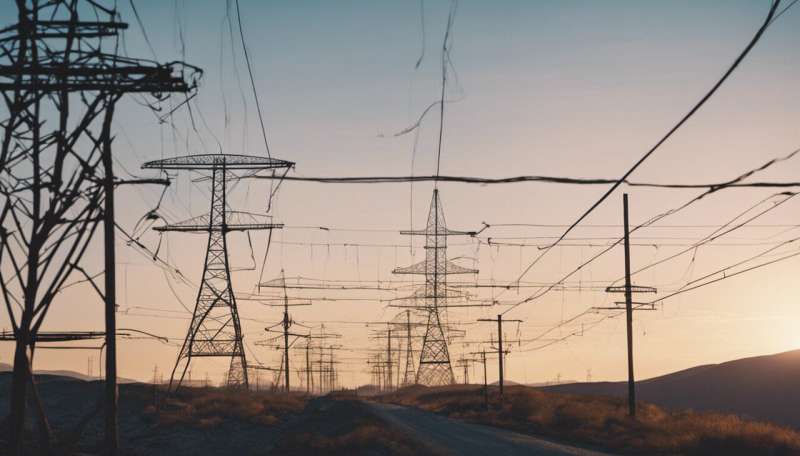Unsexy but vital: Why Australia’s warnings over grid reliability are really about building more transmission lines

“To ensure Australian consumers continue to have access to reliable electricity supplies, it’s critical that planned investments in transmission, generation and storage projects are urgently delivered.”
This week, we heard one of the strongest warnings yet from Daniel Westerman, head of the Australian Energy Market Operator (AEMO).
So far, media coverage has framed his comments as a warning about the anticipated angry El Niño summer, which is likely to drive energy-intensive aircon use even as our coal plants become less and less reliable.
But this isn’t what the warning is really about. It’s about transmission lines and our sluggish pace of change. Australia’s emissions are falling much more slowly than we’d like to think, if we omit the sometimes controversial land use sector. We’re down just 1.6% below 2005 levels.
Solar and wind farm investment has slowed markedly. This is because we don’t have the right grid—yet. Building the transmission infrastructure needed to slash emissions by 2030 means acting much faster than government is used to.
These aren’t ordinary times. We can’t act as if they are.
The grid will withstand summer—but bigger threats lie ahead
It’s quite likely the grid will withstand this summer, as long as maintenance is done to keep the old coal clunkers running and to ensure gas peaking plants are ready for times of highest demand. We also have the reserve system, whereby big energy users can be paid not to consume electricity during the hottest days.
There’s no shortage of solar and wind resources in Australia. And there’s no shortage of solar and wind farm projects waiting to be built. But the great renewable build is stalling—not because there’s no demand for cheap power, but because regulatory approvals are too slow and there’s no way to get the power to the cities and heavy industries.
The real problem is we’re not moving fast enough to build the unsexy but vital infrastructure we need: new transmission lines. The old grid was built around big power stations, from hydro in the Snowy Mountains to coal plants near coal mines, with transmission lines connecting them to cities.
But renewable-rich zones are often in different places. What’s more, shifting to a grid full of renewables means building more interconnectors between states, so on a big day for Victoria’s mooted offshore wind farms, for instance, the surplus power can be sent to South Australia, New South Wales and Queensland too.
What’s the delay? After all, we were able to build transmission lines when the current grid was taking shape.
A big part of the issue is community pushback and process. Local farmers and communities are resisting many of the planned new transmission lines.
If we had the luxury of time, it might be possible to get strong community support. But we don’t. Our coal plants are on the way out and no one is going to build a new one. The barrier between us and a clean energy future is getting transmission and storage built, fast.
Labor went to the 2022 election with a $20 billion plan to build the transmission lines envisaged by AEMO in its latest integrated system plan.
Westerman last year listed the five most urgent transmission links:
- HumeLink to bring Snowy 2.0 pumped hydro power to the grid
- the Sydney Ring, designed to improve connections between New South Wales’ four largest population centers, Sydney, the Central Coast, Newcastle and Wollongong
- transmission links from the New England renewable energy zone
- the Marinus link to better connect Tasmania’s wealth of hydro with the mainland
- the KerangLink interconnector between Victoria and New South Wales.
Most of these projects have had their own issues, ranging from lengthy approval processes, to heated community calls to put lines underground, to cost blowouts.
One problem is the range of government agencies involved. There’s no single body responsible for making these nation-building projects happen as quickly and happily as possible.
How can we speed up these vital projects?
Here are a few ideas:
- compensate affected landholders. Farmers who agree to host transmission towers get paid. To smooth the build, governments could bite the bullet and expand whom they compensate. Or, as with many other major infrastructure projects, as a last resort, they could compulsorily acquire the easements
- give one agency the responsibility and authority for making these essential projects happen
- ramp up regional training centers to produce the skilled electrical workers we’ll need.
We’ve come a fair way down the road in our efforts to wean ourselves off coal, and, eventually, gas-fired electricity. But it could all be for nought if we don’t get transmission sorted as soon as possible.
This article is republished from The Conversation under a Creative Commons license. Read the original article.![]()
Citation:
Unsexy but vital: Why Australia’s warnings over grid reliability are really about building more transmission lines (2023, August 31)
retrieved 1 September 2023
from https://techxplore.com/news/2023-08-unsexy-vital-australia-grid-reliability.html
This document is subject to copyright. Apart from any fair dealing for the purpose of private study or research, no
part may be reproduced without the written permission. The content is provided for information purposes only.
For all the latest Technology News Click Here
For the latest news and updates, follow us on Google News.

